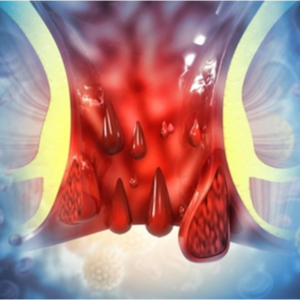
What are haemorrhoids?
Haemorrhoids (also: haemorrhoids) are the spongy, well-blooded vascular cushion at the exit of the rectum which, together with the sphincter muscle, seals the anus. If the haemorrhoids are enlarged, this can lead to a condition called haemorrhoidal disease, which can cause pain, burning and/or itching at the anus.
What are the symptoms of haemorrhoids?
People who suffer from haemorrhoids often have blood in their stools. Bright red blood indicates that the haemorrhoids are bleeding from arterial vessels. Dark red blood, on the other hand, usually comes from a venous vessel and suggests a disease of the bowel. More severe haemorrhoids cause itching and/or burning at the anus as the disease progresses. Some sufferers also have a foreign body sensation, sore and/or weeping skin in the anal region or can feel bulges.
What are the different degrees of severity of haemorrhoidal disease?
Doctors divide haemorrhoidal disease into the following four degrees of severity:
- Grade 1: is the mildest form and the most common. In this stage, the haemorrhoids are not palpable and can only be diagnosed by anal canaloscopy (proctoscopy).
- Grade 2: in this stage, the haemorrhoids bulge outwards when you push. They then retract into the anal canal on their own.
- Grade 3: Similar to grade 2, the haemorrhoids protrude from the anus when pressing. However, they do not retract into the anal canal on their own, but have to be pushed back with the finger.
- Grade 4: In this stage, the haemorrhoids are permanently visible on the outside of the anus and can no longer be pushed back into the anal canal. In some cases, some of the anal mucosa may protrude from the anus (anal prolapse).
How are haemorrhoids treated?
The treatment method for haemorrhoids always depends on the severity of the condition:
- mild haemorrhoids: are usually sclerosed by the doctor applying sclerosing substances, for example zinc chloride. This blocks the blood flow to the haemorrhoid, whereupon the tissue begins to shrink and solidify (sclerotherapy). In addition, haemorrhoids can also be iced with nitrous oxide or liquid nitrogen (cryohaemorrhoidectomy). In contrast to sclerotherapy, the chances of success with this approach are much lower.
- moderate haemorrhoids: For 2nd or sometimes 3rd degree haemorrhoids, the so-called ligation procedure is usually carried out by means of a rubber band ligation (haemorrhoid ligation). In this procedure, the doctor aspirates the individual haemorrhoids and then ties them off with rubber bands to cut off the blood supply and allow the tissue to die. When the haemorrhoids fall off, which should happen after about one to two weeks, bleeding may occur.
- severe haemorrhoids: Here, haemorrhoid surgery is usually considered as a last resort. This involves completely removing the haemorrhoids by means of a surgical procedure (haemorrhoidectomy). Different techniques can be used for haemorrhoid surgery: Using scissors, a scalpel or laser, the haemorrhoidal tissue can be cut out.
In any case, the basis of any haemorrhoid therapy is a balanced diet to ensure regular bowel movements. By the way, both factors can also help prevent the development of haemorrhoids.
Conservative measures are often used to treat haemorrhoids. These include pain-relieving ointments, which can be helpful for all degrees of severity. Some ointments reduce inflammation, while others have a local anaesthetic effect:
- anti-inflammatory ointments: These include wound ointments, plant-based ointments (witch hazel or aloe vera) or zinc pastes, which are good for treating painful haemorrhoids and complaints such as skin irritation and itching. In particularly severe cases, the doctor can also prescribe an ointment containing cortisone, for example prednisolone or hydrocortisone acetate. These substances are supposed to inhibit the immune system and thus counteract the inflammation at the anus.
- local anaesthetics: Local anaesthetics such as benzocaine, cinchocaine or lidocaine locally anaesthetise the affected skin area and help the patient feel neither itching nor pain. However, similar to coritson ointments, these local anaesthetics may only be used for a short time, as they can otherwise cause allergies.
Which classic home remedies can help with haemorrhoids?
Classic home remedies for haemorrhoids can not only provide relief for mild symptoms of the disease and contribute to the disappearance of haemorrhoids. Home remedies can also provide relief for patients with more severe degrees. For example, sitz baths with anti-inflammatory tanning agents can help sufferers relieve their itching and pain at the anus. If the patient also suffers from constipation, flaxseed with plenty of liquid can make bowel movements easier.
How can haemorrhoids be prevented?
A diet rich in fibre and regular bowel movements are the key to preventing haemorrhoids. The following applies here:
- a high-fibre diet to prevent constipation by eating muesli, wholemeal bread, sesame seeds, vegetables, wheat bran, oatmeal, pulses and fresh fruit.
- a sufficient fluid intake of at least 1.5 litres of fluid per day. Water, calorie-free drinks and unsweetened tea are recommended.
- Avoid foods that promote constipation, such as chocolate, white rice and/or pasta, and white bread.
- get sufficient and regular exercise,
- Avoid being overweight.
